Mattingly J.D., Heiser W.H., Pratt D.T. Aircraft Engine Design
Подождите немного. Документ загружается.

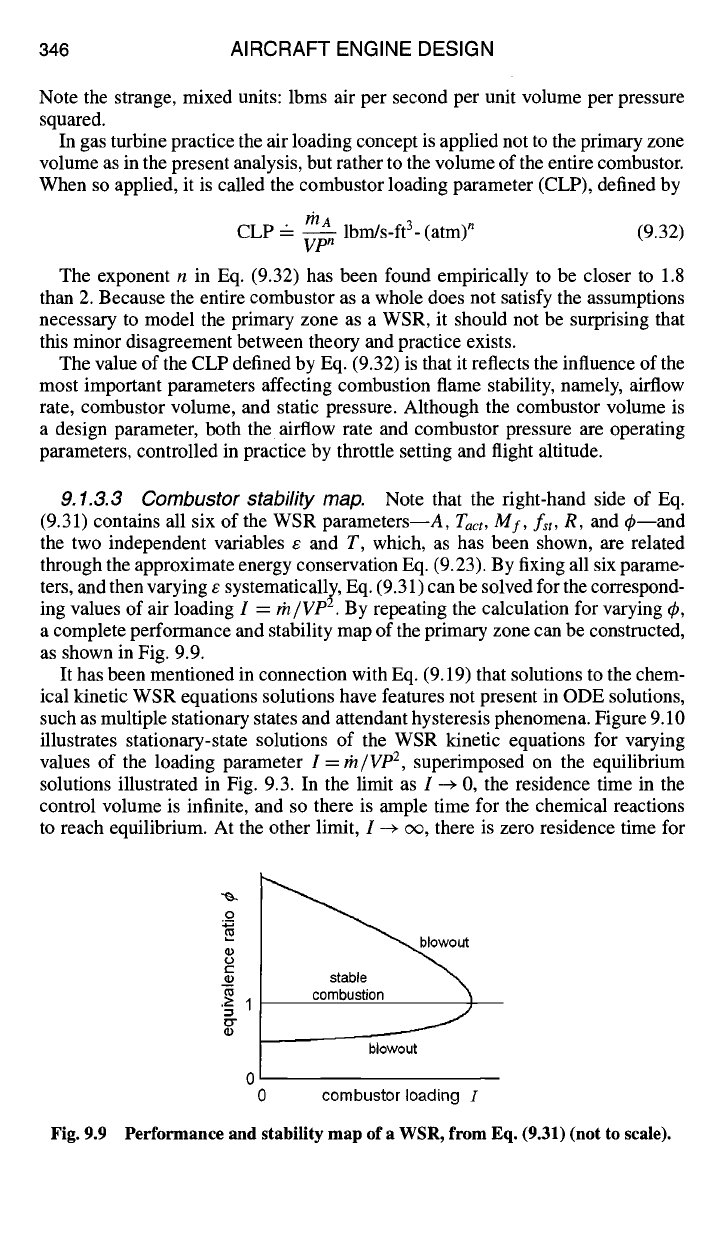
346 AIRCRAFT ENGINE DESIGN
Note the strange, mixed units: lbms air per second per unit volume per pressure
squared.
In gas turbine practice the air loading concept is applied not to the primary zone
volume as in the present analysis, but rather to the volume of the entire combustor.
When so applied, it is called the combustor loading parameter (CLP), defined by
/'h A
CLP "-- ~ lbm/s-ft 3- (atm) n (9.32)
The exponent n in Eq. (9.32) has been found empirically to be closer to 1.8
than 2. Because the entire combustor as a whole does not satisfy the assumptions
necessary to model the primary zone as a WSR, it should not be surprising that
this minor disagreement between theory and practice exists.
The value of the CLP defined by Eq. (9.32) is that it reflects the influence of the
most important parameters affecting combustion flame stability, namely, airflow
rate, combustor volume, and static pressure. Although the combustor volume is
a design parameter, both the airflow rate and combustor pressure are operating
parameters, controlled in practice by throttle setting and flight altitude.
9.1.3.3 Combustor stability map.
Note that the right-hand side of Eq.
(9.31) contains all six of the WSR parameters--A,
Tact, Mf, fst,
R, and ~b--and
the two independent variables e and T, which, as has been shown, are related
through the approximate energy conservation Eq. (9.23). By fixing all six parame-
ters, and then varying e systematicall~y, Eq. (9.31) can be solved for the correspond-
ing values of air loading I =
rn/VP ~.
By repeating the calculation for varying ~b,
a complete performance and stability map of the primary zone can be constructed,
as shown in Fig. 9.9.
It has been mentioned in connection with Eq. (9.19) that solutions to the chem-
ical kinetic WSR equations solutions have features not present in ODE solutions,
such as multiple stationary states and attendant hysteresis phenomena. Figure 9.10
illustrates stationary-state solutions of the WSR kinetic equations for varying
values of the loading parameter I =
r'n/VP 2,
superimposed on the equilibrium
solutions illustrated in Fig. 9.3. In the limit as I --~ 0, the residence time in the
control volume is infinite, and so there is ample time for the chemical reactions
to reach equilibrium. At the other limit, I ~ cx~, there is zero residence time for
Fig. 9.9
o
65
cD
¢.)
_.e
O"
(D
ut
blowout
0 combustor loading I
Performance and stability map of
a WSR,
from Eq.
(9.31) (not
to scale).

DESIGN: COMBUSTION SYSTEMS 347
H (/= 0)~.~
T
Fig. 9.10 Variation of WSR chen~cal kinetic stationary states wRh loading parameter
I = m/vP ~
(Ref. 9).
the reactions to occur, so that the reactants simply exit the control volume without
chemical change, with combustion efficiency e given by Eq. (9.23).
As the loading is increased from zero to 11, there is now finite residence time
in the control volume, and so the reactions fail to reach the equilibrium state, and
their temperature is lower than the AFT, as illustrated by curve 1 in Fig. 9.10.
Further increasing the loading to 12 causes further reduction in stationary-state
temperature as a result of incomplete combustion.
9.1.4
Stirring and Mixing
In the main burner, round jets and swirling annular jets are utilized to mix fuel
and air to flammable proportions, and to mix burned gases with fresh reactant
gases, for both flameholding and burnout to completion. In the afterburner, these
same ends are achieved by shear layer mixing between co-flowing streams. In this
section the fluid mechanics and aerodynamics of these three fluid mixing systems
are presented in order.
9.1.4.1 Round jets.
Consider the turbulent jets of fluid issuing from sharp-
edged, round holes, such as those shown in Fig. 9.1, for admitting air into the
secondary and dilution zones of the main burner.
In Fig. 9.11 the annulus and liner regions are assumed to be semi-infinite reser-
voirs containing two different fluids having mass densities
PA
and
PL,
respectively.
The fluids will be assumed to be "Boussinesq" fluids, that is, they are incompress-
ible, with mass densities that vary with temperature but not with pressure. 11
If the liner region has a lower static pressure than the annulus region above,
the pressure difference causes a jet to flow through the hole of area Ah =
rrd2/4.
As the locally reduced pressure around the hole draws the fluid into the opening,
a vena contracta forms, so that the entering jet velocity Vj occurs at the reduced
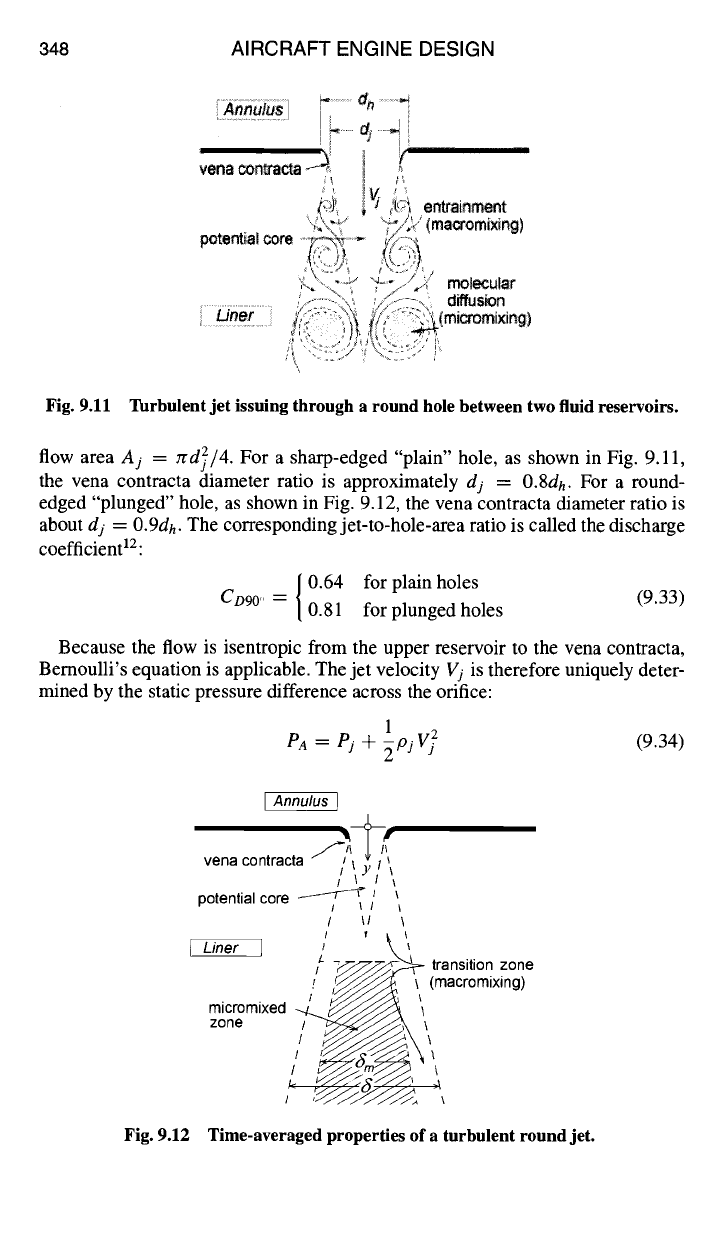
348 AIRCRAFT ENGINE DESIGN
i!
' i ........
vo°a I: i
!i
(~' ~ s
,,~.~
entrainment
'~;~." ~"
~-'~+"
(macromixing)
pote~al core
-".~ ~(JT:'-~
.~'-J'C'.~ "~D". ~i' molecular
................................ ' ............ ?'0 ,'/;1 ........ .,' diffusion
Liner
:I(~S::< }~'~
~'/,
i':'!~[.i'i, (micromixing)
......
) ,(i ,
~s
Fig. 9.11 Turbulent jet issuing through a round hole between two fluid reservoirs.
flow area
Aj = nd2/4.
For a sharp-edged "plain" hole, as shown in Fig. 9.11,
the vena contracta diameter ratio is approximately dj =
0.8dh.
For a round-
edged "plunged" hole, as shown in Fig. 9.12, the vena contracta diameter ratio is
about
dj = 0.9dh.
The corresponding jet-to-hole-area ratio is called the discharge
coefficientl2:
0.64 for plain holes
CD90'.
= 0.81 for plunged holes (9.33)
Because the flow is isentropic from the upper reservoir to the vena contracta,
Bemoulli's equation is applicable. The jet velocity
Vj
is therefore uniquely deter-
mined by the static pressure difference across the orifice:
1
PA = Pj + ~Pj V 2
(9.34)
vena contracta / /~ 'j' I~
I ~ I1 ~
~.., ,,',o~ent~a ~core ~ t
// ~ I I
s -,/'-~7-/~.~ transition zone
, Y/~/___~ '\ (macromixing)
/'
Fig. 9.12 Time-averaged properties of a turbulent round jet.
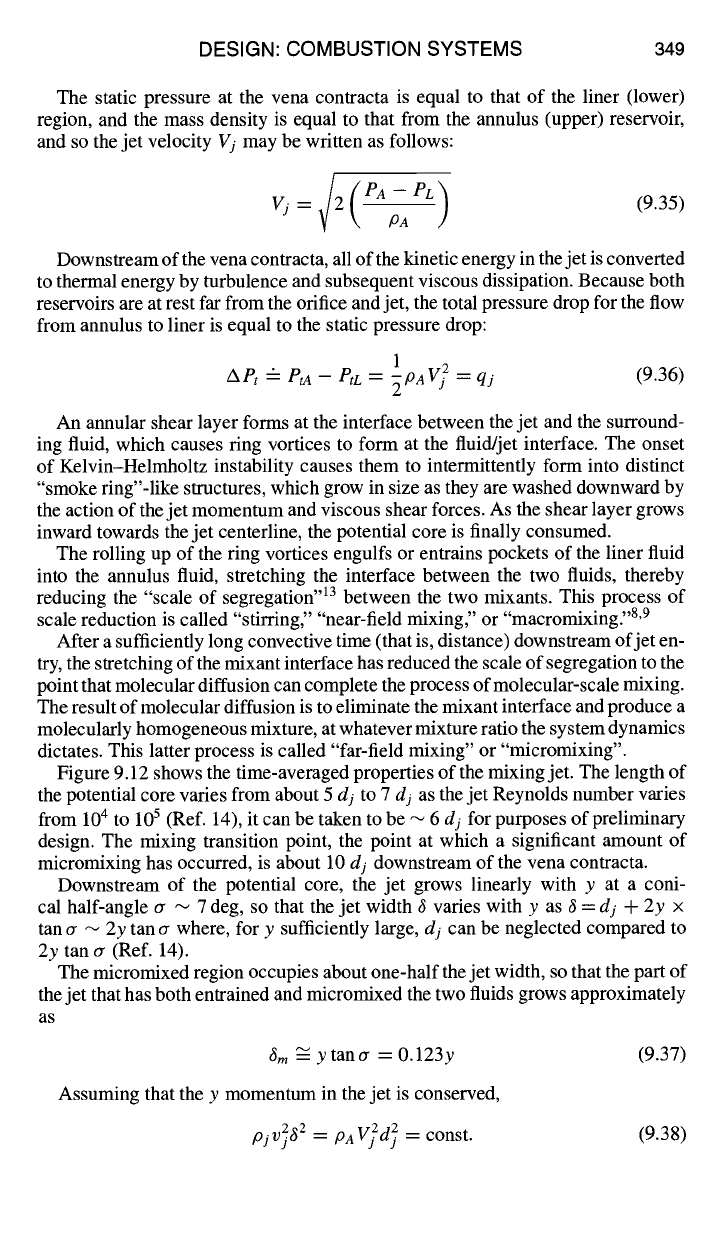
DESIGN: COMBUSTION SYSTEMS 349
The static pressure at the vena contracta is equal to that of the liner (lower)
region, and the mass density is equal to that from the annulus (upper) reservoir,
and so the jet velocity
Vj
may be written as follows:
gj=~2( PA-~PL
(9.35)
Downstream of the vena contracta, all of the kinetic energy in the jet is converted
to thermal energy by turbulence and subsequent viscous dissipation. Because both
reservoirs are at rest far from the orifice and jet, the total pressure drop for the flow
from annulus to liner is equal to the static pressure drop:
APt -- PtA -- PtL = ~PA V2 = qj
(9.36)
An annular shear layer forms at the interface between the jet and the surround-
ing fluid, which causes ring vortices to form at the fluid/jet interface. The onset
of Kelvin-Helmholtz instability causes them to intermittently form into distinct
"smoke ring"-like structures, which grow in size as they are washed downward by
the action of the jet momentum and viscous shear forces. As the shear layer grows
inward towards the jet centerline, the potential core is finally consumed.
The rolling up of the ring vortices engulfs or entrains pockets of the liner fluid
into the annulus fluid, stretching the interface between the two fluids, thereby
reducing the "scale of segregation ''13 between the two mixants. This process of
scale reduction is called "stirring," "near-field mixing," or "macromixing "'8'9
After a sufficiently long convective time (that is, distance) downstream of jet en-
try, the stretching of the mixant interface has reduced the scale of segregation to the
point that molecular diffusion can complete the process of molecular-scale mixing.
The result of molecular diffusion is to eliminate the mixant interface and produce a
molecularly homogeneous mixture, at whatever mixture ratio the system dynamics
dictates. This latter process is called "far-field mixing" or "micromixing".
Figure 9.12 shows the time-averaged properties of the mixing jet. The length of
the potential core varies from about 5
dj
to 7
dj
as the jet Reynolds number varies
from 104 to 105 (Ref. 14), it can be taken to be ~ 6
dj
for purposes of preliminary
design. The mixing transition point, the point at which a significant amount of
micromixing has occurred, is about 10
dj
downstream of the vena contracta.
Downstream of the potential core, the jet grows linearly with y at a coni-
cal half-angle ~r ~ 7 deg, so that the jet width ~ varies with y as ~ =
dj + 2y x
tan cr ~ 2y tan cr where, for y sufficiently large,
dj
can be neglected compared to
2y tan a (Ref. 14).
The micromixed region occupies about one-half the jet width, so that the part of
the jet that has both entrained and micromixed the two fluids grows approximately
as
6m -~
ytan~r = 0.123y
Assuming that the y momentum in the jet is conserved,
pj 1)232 2 2
= PA V) dj
= const.
(9.37)
(9.38)

350 AIRCRAFT ENGINE DESIGN
Annulus
Fig. 9.13 Two round jets with same velocity, but with hole diameters different by a
factor of 2.
then the average y component of the jet velocity Uj varies inversely with y as
Vjdj 1
vj = '--~/ pj 2-~an-a y
(9.39)
In Fig. 9.13 a pair of jets are shown issuing through two round holes, the diameter
of the hole on the left being two times that of the hole on the right.
Figure 9.13 illustrates that, although the pressure difference between the reservoirs
uniquely determines the jet velocity and total pressure loss [Eqs. (9.35) and (9.36)],
the hole diameter uniquely determines the penetration depth and structure of the
jet [Eqs. (9.37-9.39)]. For the case shown, the mass flow rate through the larger
hole is four times that of the smaller hole.
9. 1.4.2 Jet flowing into a cross stream.
Figure 9.14 is a schematic draw-
ing
of a turbulent round jet flowing from the upper annulus reservoir into the liner
zj~ _ , -.x
mi×Jng ~ \ \
Fig. 9.14 Jet issuing from a reservoir into a cross stream. Is

DESIGN: COMBUSTION SYSTEMS 351
region, as before. However, the liner fluid is now also in motion, flowing from left
to right with a velocity UL. The cross-stream flow sees the vertical jet as a cylindri-
cal obstruction in the flow, and so it exerts an aerodynamic drag force upon it. The
jet, being a compliant structure rather than a rigid cylinder, deforms in response
to the drag force and is bent up horizontally as it is washed downstream.
In addition to the jet entrainment as a result of the sequence of ring vortices,
as sketched in Fig. 9.11, there is now an additional set of horseshoe vortices, as
depicted in Fig. 9.14, which have vertical vortex filaments, established in the wake
of the jet. 15 This creates a second mixing system extending in the x direction that
is, downstream in the sense of UL--in addition to the jet mixing region as a result
of the ring vortices, which extends in the y direction, downstream in the sense of
vj.
An expression for the trajectory of the jet centerline is given by Lefebvre2:
Y 0.82 j0.5 (X ~ 0"33
/gA V2
qj
--dj
= \~j-j/ where J - pL--U 2 -- qL (9.40)
A derivation of Eq. (9.40) can be found in Ref. 14.
As the jet mixes out into the flowing stream, the jet centerline must eventually
become parallel to the velocity UL. However, the one-third power exponent in
Eq. (9.40) does not approach an asymptote for Y as X increases, so Eq. (9.40)
describes the jet trajectory only in the near field. Lefebvre gives an empirical
equation for the asymptote, namely, the maximum jet penetration depth, 2
Ymax
--
1.15 j0.5
(9.41)
d:
9.1.4.3 Jet from a crossflowing annulus. If the fluid in the annulus is
moving from left to right at velocity UA,
as
depicted in Fig. 9.15, then the fluid
entering the jet carries with it its axial momentum flux/9 3
U 2
in addition to the
.....
t'~¢
.............
~-#11# ......... -'
...............
Ut. "
Fig. 9.15 Jet issuing from an annulus with velocity
UA
into a stream with velocity
UL
(Ref. 2).
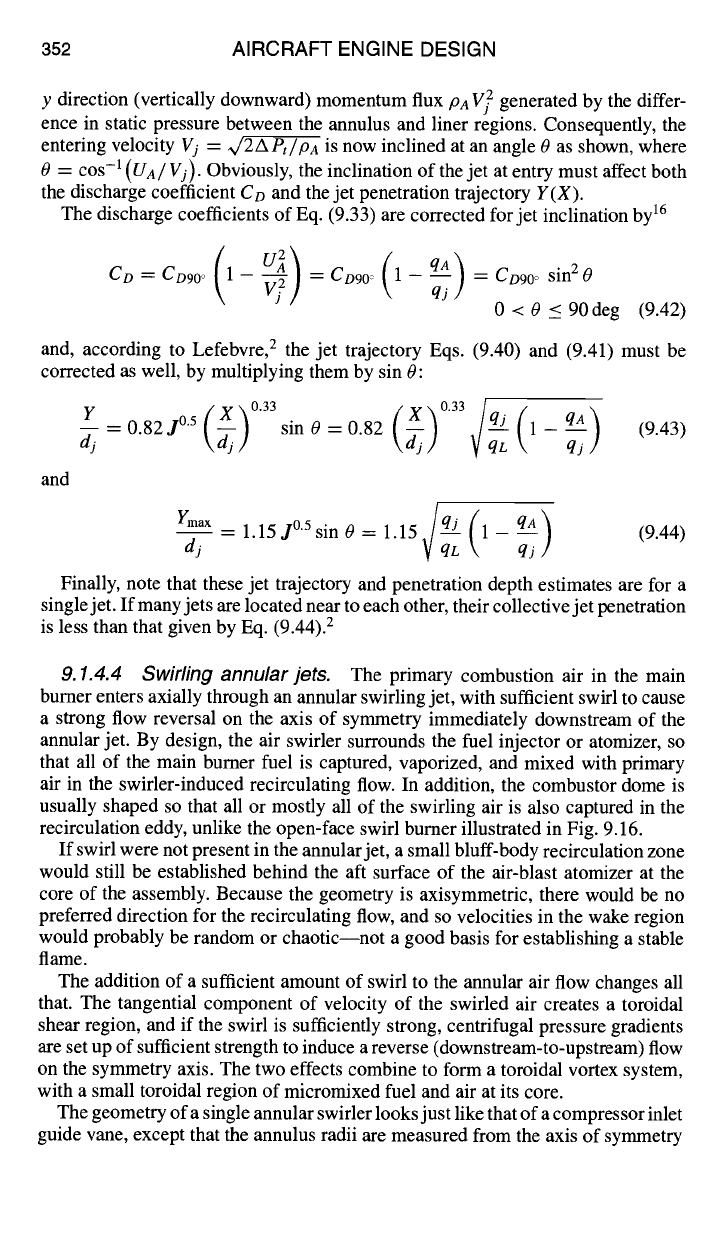
352 AIRCRAFT ENGINE DESIGN
y direction (vertically downward) momentum flux
PA
g 2
generated by the differ-
ence in static pressure between the annulus and liner regions. Consequently, the
entering velocity
Vj = 2v'2A~t/pA
is now inclined at an angle 0 as shown, where
0 = cos -1
(UA/Vj).
Obviously, the inclination of the jet at entry must affect both
the discharge coefficient
CD
and the jet penetration trajectory
Y(X).
The discharge coefficients of Eq. (9.33) are corrected for jet inclination by 16
CD=CD9oo(1--U~=Co9oo(1 -qA)
W: } -~j : CD90°
sin20
0<0_<90deg (9.42)
and, according to Lefebvre, 2 the jet trajectory Eqs. (9.40) and (9.41) must be
corrected as well, by multiplying them by sin 0:
and
( t
Y 0.82 j0.5 sin 0 = 0.82
qj qA
d j \ d j ] \-dj ] -~L 1-- --~j
(9.43)
Ymax-l.15J°'SsinO=l.15~( 1 q:)
dj
- (9.44)
Finally, note that these jet trajectory and penetration depth estimates are for a
single jet. If many jets are located near to each other, their collective jet penetration
is less than that given by Eq. (9.44). 9
9.1.4.4 Swirling annular jets.
The primary combustion air in the main
bumer enters axially through an annular swirling jet, with sufficient swirl to cause
a strong flow reversal on the axis of symmetry immediately downstream of the
annular jet. By design, the air swirler surrounds the fuel injector or atomizer, so
that all of the main burner fuel is captured, vaporized, and mixed with primary
air in the swirler-induced recirculating flow. In addition, the combustor dome is
usually shaped so that all or mostly all of the swirling air is also captured in the
recirculation eddy, unlike the open-face swirl burner illustrated in Fig. 9.16.
If swirl were not present in the annular jet, a small bluff-body recirculation zone
would still be established behind the aft surface of the air-blast atomizer at the
core of the assembly. Because the geometry is axisymmetric, there would be no
preferred direction for the recirculating flow, and so velocities in the wake region
would probably be random or chaotic--not a good basis for establishing a stable
flame.
The addition of a sufficient amount of swirl to the annular air flow changes all
that. The tangential component of velocity of the swirled air creates a toroidal
shear region, and if the swirl is sufficiently strong, centrifugal pressure gradients
are set up of sufficient strength to induce a reverse (downstream-to-upstream) flow
on the symmetry axis. The two effects combine to form a toroidal vortex system,
with a small toroidal region of micromixed fuel and air at its core.
The geometry of a single annular swirler looks just like that of a compressor inlet
guide vane, except that the annulus radii are measured from the axis of symmetry

DESIGN: COMBUSTION SYSTEMS 353
0 10 20 30 40 50 60 70
AXIAL DISTANCE cm
Fig. 9.16 Streamlines of recirculation eddy in swirling annular jet, for swirl number
S' = 1.57 (Ref. 17).
of the atomizer/swirler assembly, and not from the engine axis. Denoting the inner
("hub") radius of the annular area by
rh
and the outer ("tip") radius by
rt, the
axial
flow area of each swirler is simply
Asw = rr(r 2 - r2),
neglecting the thickness of
the swirl vanes.
The swirler vanes are designed with a solidity of about one, at an off-axial angle
~,w such that the air leaving the swirler at velocity Vj has axial and tangential
velocity components U =
Vj
cos Ot,w and W = Vj sin
asw,
respectively. Note
well that this value of Vj is precisely the same jet velocity determined by the
combustor total pressure drop given by Eq. (9.36),
1 2
APt "-- Ptr - PtL = ~ pr Vj
and that the discharge coefficient for the annular jet is simply
Co
=
CD90 o
COS
Olsw ,
where
Co9o.
is the sharp-edged hole discharge coefficient given by Eq. (9.33).
The amount or degree of swirl imparted to the flow is quantified by the swirl
number S t, defined by 17
S'- G~/Gtxr t
(9.45)
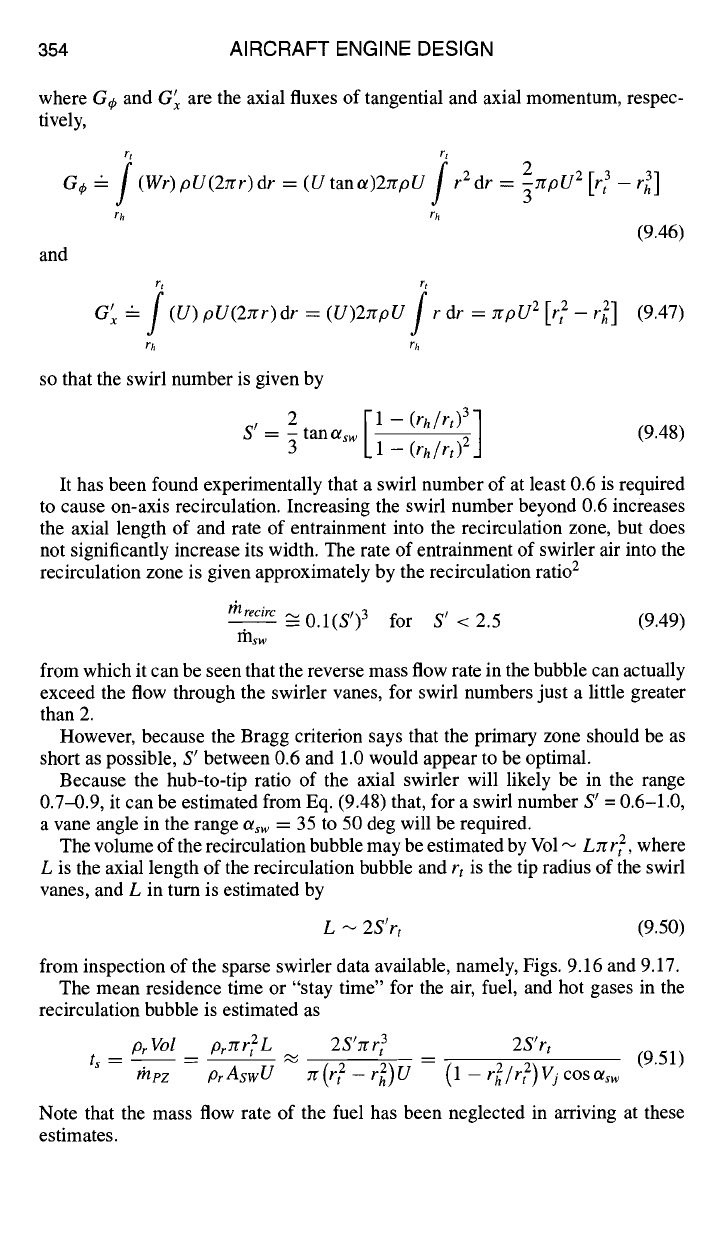
354 AIRCRAFT ENGINE DESIGN
where G o and
G' x are
the axial fluxes of tangential and axial momentum, respec-
tively,
rt rt
f f
Ge - (Wr) pU(2~rr)dr = (U tanu)27rpU
r2dr =
5~pU
[r 3 -r 3]
rh rh
(9.46)
and
rt rt
go
- /r r =
7rpU2 [r2t - r~]
(9.47)
rh rh
so that the swirl number is given by
S' 2 [1 -
(rh/rt)31
(9.48)
= -~ tanotsw 1 (rh/rt)2.]
It has been found experimentally that a swirl number of at least 0.6 is required
to cause on-axis recirculation. Increasing the swirl number beyond 0.6 increases
the axial length of and rate of entrainment into the recirculation zone, but does
not significantly increase its width. The rate of entrainment of swirler air into the
recirculation zone is given approximately by the recirculation ratio 2
mrecirc ~
0.1(S,)3 for S' < 2.5 (9.49)
lnsw
from which it can be seen that the reverse mass flow rate in the bubble can actually
exceed the flow through the swirler vanes, for swirl numbers just a little greater
than 2.
However, because the Bragg criterion says that the primary zone should be as
short as possible, S' between 0.6 and 1.0 would appear to be optimal.
Because the hub-to-tip ratio of the axial swirler will likely be in the range
0.7-0.9, it can be estimated from Eq. (9.48) that, for a swirl number S' = 0.6-1.0,
a vane angle in the range Oqw = 35 to 50 deg will be required.
The volume of the recirculation bubble may be estimated by Vol ~ Lzr rt 2, where
L is the axial length of the recirculation bubble and rt is the tip radius of the swirl
vanes, and L in turn is estimated by
L ~ 2S'rt
(9.50)
from inspection of the sparse swirler data available, namely, Figs. 9.16 and 9.17.
The mean residence time or "stay time" for the air, fuel, and hot gases in the
recirculation bubble is estimated as
Pr Vol przr rZ L 2S'rc r3t 2S' rt
ts- ---- ~ -- (9.51)
2 2
&Pz praswU 7r(r 2 - rZ)U
(1 -
rh/r t )Vj
cos ~sw
Note that the mass flow rate of the fuel has been neglected in arriving at these
estimates.
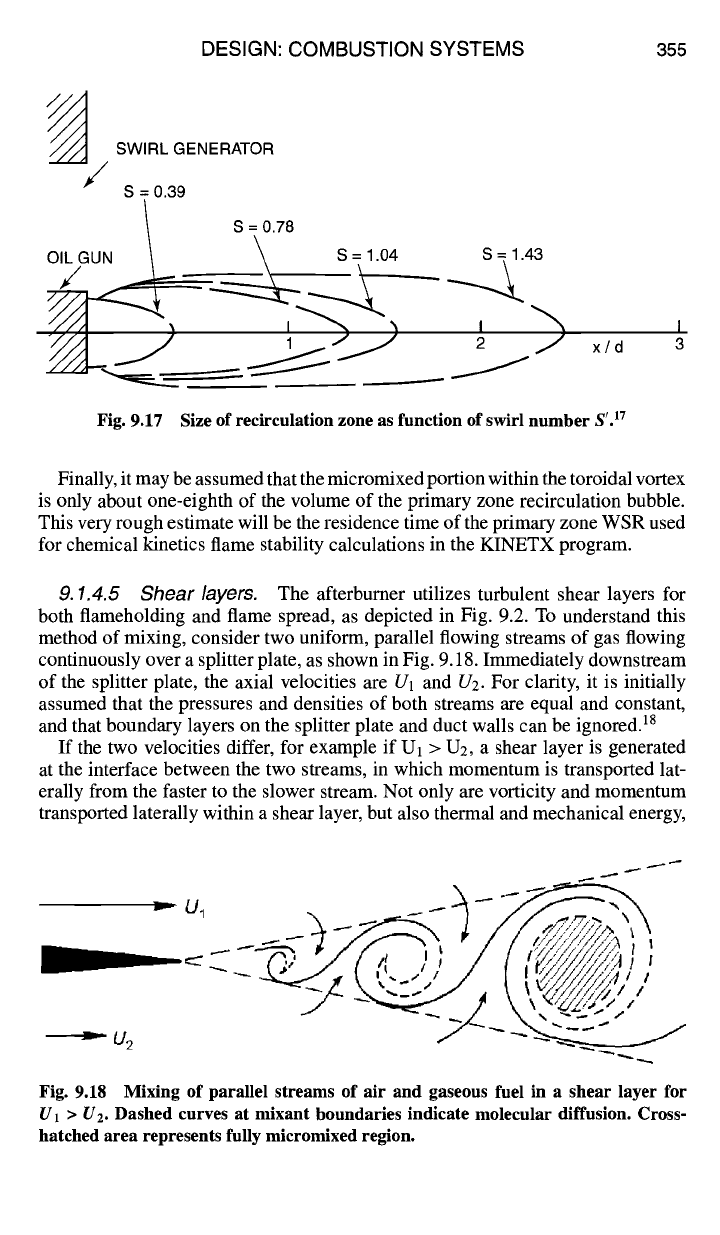
DESIGN: COMBUSTION SYSTEMS 355
"•/
SWIRL GENERATOR
S = 0.39
S = 0.78
OILGUN L ~ S=1'04 .~43
I
x/d 3
Fig. 9.17 Size of recirculation zone as function of swirl number
S:. 17
Finally, it may be assumed that the micromixed portion within the toroidal vortex
is only about one-eighth of the volume of the primary zone recirculation bubble.
This very rough estimate will be the residence time of the primary zone WSR used
for chemical kinetics flame stability calculations in the KINETX program.
9.1.4.5 Shear layers.
The afterburner utilizes turbulent shear layers for
both flameholding and flame spread, as depicted in Fig. 9.2. To understand this
method of mixing, consider two uniform, parallel flowing streams of gas flowing
continuously over a splitter plate, as shown in Fig. 9.18. Immediately downstream
of the splitter plate, the axial velocities are U1 and U2. For clarity, it is initially
assumed that the pressures and densities of both streams are equal and constant,
and that boundary layers on the splitter plate and duct walls can be ignored. 18
If the two velocities differ, for example if U1 > U2, a shear layer is generated
at the interface between the two streams, in which momentum is transported lat-
erally from the faster to the slower stream. Not only are vorticity and momentum
transported laterally within a shear layer, but also thermal and mechanical energy,
Fig. 9.18 Mixing of parallel streams of air and gaseous fuel in a shear layer for
U1 > U2. Dashed curves at mixant boundaries indicate molecular diffusion. Cross-
hatched area represents fully micromixed region.
